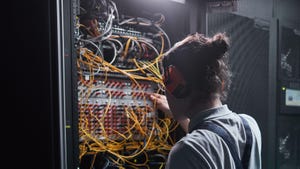How AI is Shaping the Future of Data StorageHow AI is Shaping the Future of Data Storage
AI is driving smarter, more efficient data storage while relying on it in turn. Can storage innovation keep up with AI’s ever-growing demands?

What will it take for society to trust AI? Every decision, prediction, and insight generated by AI algorithms hinges on the availability and quality of data. Data must be stored effectively and efficiently to fully harness AI’s potential. In other words, data upholds AI, and storage upholds data. The enablement is mutual: AI also strengthens today’s storage innovations to serve its needs.
To understand how AI helps create better storage solutions, let’s first examine its relationship with data. AI data exists in a loop of data generation and consumption, where more high-quality, varied input data leads to smarter models and better results. Throughout this loop, AI becomes a data creation force multiplier, and the growing demand for mass-capacity storage solutions is significant.
However, a disparity persists. Seagate analysis based on IDC’s 2024 Global DataSphere research indicates that between 2024 to 2028, data will grow at a rate of 25%, while storage installed base is estimated to grow slower at a CAGR of 17%.

Seagate’s depiction of The Infinite Data Loop of data generation and consumption.
This disparity has business implications for enterprises: organizations need to build long-term capacity plans to ensure that their data storage infrastructure is ready to monetize the opportunity ahead.
Advancements in storage density make it possible to meet the growing demand for AI data storage at scale while minimizing footprint expansion and resource impact. For example, advancements in areal density have led to hard drives with more than 3 TB of storage per platter, improving power efficiency and reducing embodied carbon on a per-terabyte basis.
AI is an important cause and effect in this innovation: AI enables the improvement of data storage design, which in turn helps organizations get the most value out of their data in AI processing.
As an example, Seagate is using NVIDIA technologies to meet growing AI storage demands and develop future generations of its Mozaic hard drives. Working with NVIDIA, Seagate optimizes workflows, enhancing efficiency, performance, and scalability. The collaboration focuses on various aspects of simulation workflows, including model building, solution algorithms, post-processing, and visualization tasks.
By resolving significant challenges in storage hard drive design processes caused by traditional CPU simulations and cumbersome workflows, the team could speed up its hard drive designs. By speeding electromagnetic simulations with GPU-accelerated computing, goals of shortening the data storage design lifecycle, improving time to market, and aligning with sustainability goals are also met.
Through more upfront product modeling and design optimization, companies can handle more complex models, reduce prototyping and physical testing, lower energy consumption in the design process, and develop more energy-efficient storage solutions.
The benefits of this approach extend to stakeholders as well, such as fostering agility and competitiveness for all. Customers gain faster access to next-gen hard drive innovations, optimize operations sooner, and achieve quicker return on investment. Partners benefit from dynamic collaboration, accelerated market reach, and enhanced resource efficiency. As data storage demands grow with the rise of AI, technology partnerships help ensure that the industry leads with faster, more energy-efficient solutions and meets the storage demands of AI.
The hard drive industry isn’t new to such innovations. For decades, it has been at the forefront of integrating AI, machine learning (ML), and other advanced technologies into product development and manufacturing processes. This dedication is evident in the numerous AI solutions currently deployed on production lines. These solutions not only improve efficiency for frontline workers but also result in faster problem resolution.
As the boundaries of data storage continue to be pushed, the tech industry is poised to adopt the next generation of faster, more capacious, and energy-efficient storage solutions. These innovations will meet the growing demand for data storage in the AI era. With each of these new advancements, technology leaders are not just keeping pace with today’s data storage demands but are shaping the future of their industries.
About the Authors
You May Also Like











